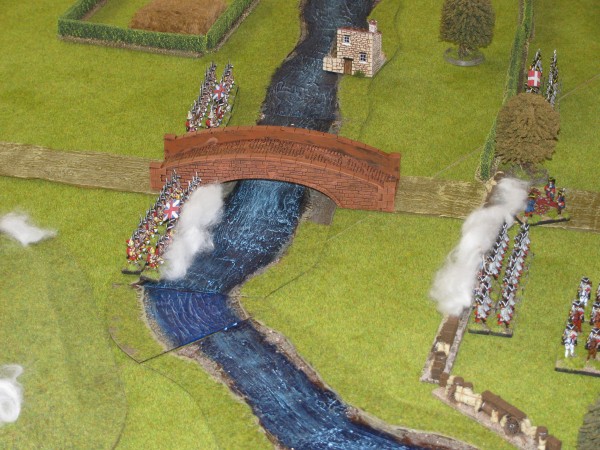Having quickly occupied Beckstein, the Allies were confident of a swift capture of Frankenberg itself. However, the French commander Le Comte de Fois-Gras had not been idle. He had constructed a fortified line along the River Klein-Rhein (a tributary of the River Frank), and garrisoned it with a strong force. On the 14th May the Allies, consisting largely of British troops under Lord William Maykit (Willie to his friends) camped in the shadow of the Rheinberg hill, in preparation for an advance over the Klein-Rhein the following morning. Maykit was visibly agitated when informed by his scouts that evening of the strength of the French position.
Maykit ordered further scouting and decided on a bold manoeuvre. He would conduct a flanking movement before dawn, whilst demonstrating against the lines with two regiments of English infantry. He hoped to sneak across the Klein-Rhein under the noses of the garrison of Rheineck and assault the French position from the rear.
At 4.30 in the morning of the 15th the advance began, but it was hamstrung by delays.
Dispositions for the battle at dawn, 15th May
Artillery opened up on the French lines from the Rheinberg as Churchill’s and Stanhope’s regiments prepared to engage the main French defences. The plan was to trade shots from the far bank of the river in order to pin the French and generate enough smoke to convince the enemy that the main assault was coming. Initially, Fois-Gras fell for this and sent the La Marck Regiment and Gendarmerie to assist.
But as the first rays of light burst forth, glints from the equipment of the flanking force were seen approaching. a hasty order was rushed to the Gendarmerie – turn to face this new threat. The Gardes Francaises, also about to leave the city were halted and ordered to man the ramparts of Rheineck. Things were looking ominous for the Allies.
The first of the flanking force to cross the Klein-Rhein was Wyndham’s Horse. They were engaged by the Gendarmerie as the British Foot Guards and Hoornberg’s horse completed their crossing. Caught by the gentlemen of France in a headlong charge, the British would not stand. The unit broke and fled the table, and being shaken were unable to return. The Villequier Chevaux-Legers and La Marck regiment also became aware of what was happening and began to move to the aid of the Gendarmerie.
The front as seen from behind Rheineck. Note that the flanking force is not in view.
Meanwhile, Sir Edward Weighward commanding the pinning force had completely lost his head and ordered an advance on the French lines wading through the Klein-Rhein either side of the bridge. Apparently Sir Edward had been present at the Boyne, and was convinced wading through rivers was a perfectly acceptable way to get to grips with the enemy! The results were going to be all too predictable.
Hoornberg’s Horse charged into the Gendarmerie, who were still a little disordered after their previous charge. In a matter of minutes the gentlemen had been repulsed. The Foot Guards became embroiled in a fire fight with the Gardes Francaises. It should have been an even contest, but the Frenchmen were secure behind fortifications. The English Guards were taking a pounding.
The Villequier Chevaux-leger charged into the Dutch cavalry and sent them reeling from the battlefield. The English Guards finally collapsed under a weight of fire, and Churchill’s and Stanhope’s Regiment streamed off towards Beckstein. Only the Brandenbourg Regiment and the artillery were left in any fit state to resist, and were able to retreat safely.
The first battle of Rheineck was a tragic failure for Maykit, despite an audacious plan that might have worked with a little more luck. Weighward’s waste of the pinning force was roundly condemned but the man himself lay dead at the bottom of the Klein-Rhein and was not going to be responsible for any more stuff-ups!
The Allies fell back on Beckstein to rebuild and recover. The French got drunk.
The firefight that turned into a tragic advance for the Allies
The game was a solo affair designed to further familiarise myself with the Black Powder Rules. It also gave me an opportunity to put all my models on the table for the first time since I shifted house. Very enjoyable way to spend a couple of hours.
The Allies must try again soon – but will it be a new plan? Will there be a new commander? Which other regiments will arrive to help out? Stay tuned and find out!



No comments:
Post a Comment